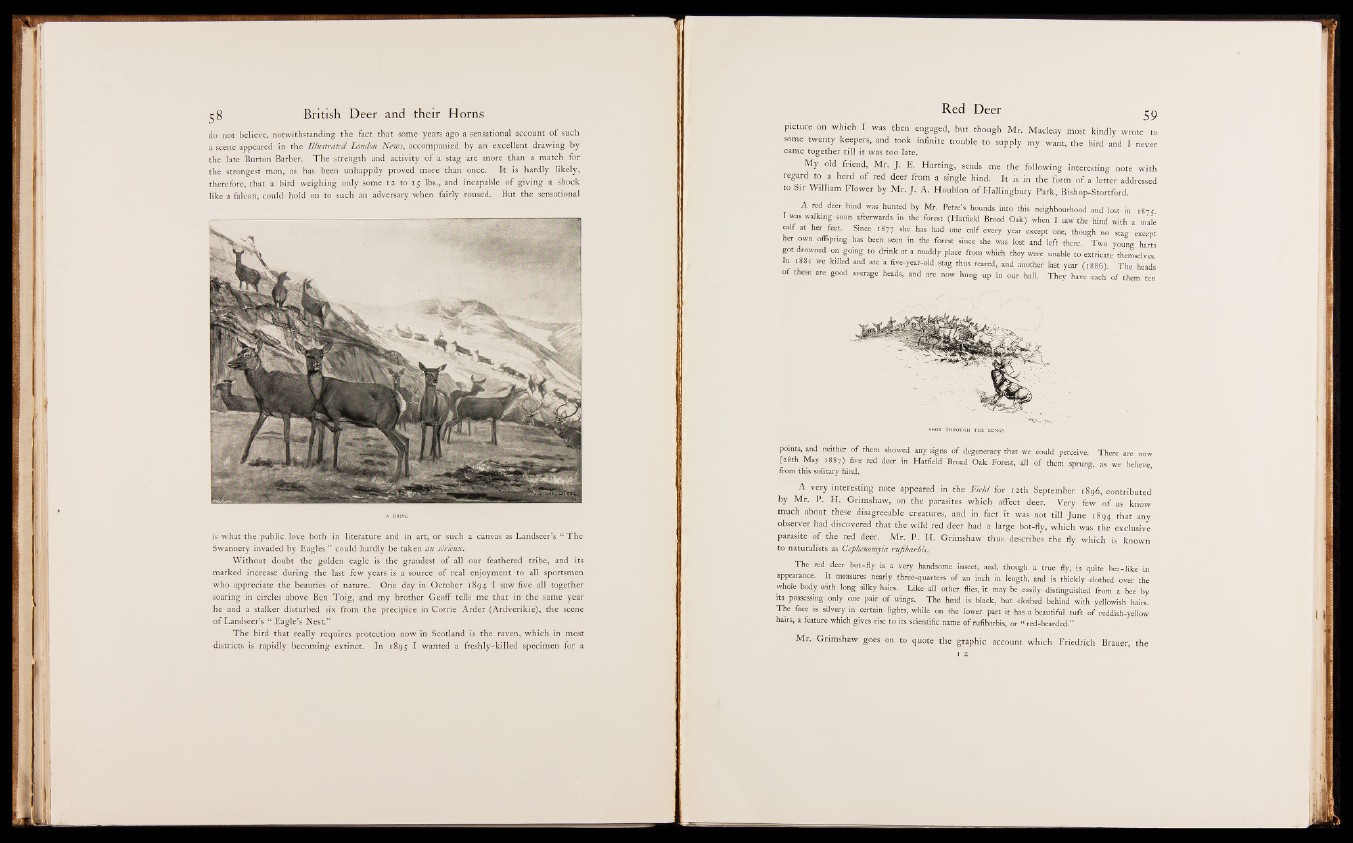
do not believe, notwithstanding the fact that some years ago a sensational account o f such
a scene appeared in the Illustrated London News, accompanied by an excellent drawing by
the late Burton Barber. The strength and activity o f a stag are more than a match for
the strongest man, as has been unhappily proved more than once. It is hardly likely,
therefore, that a bird weighing only some 12 to 15 lbs., and incapable o f giving a shock
like a falcon, could hold on to such an adversary when fairly roused. But the sensational
is what the public love both in literature and in art, or such a canvas as Landseer’s “ The
Swannery invaded by Eagles ” could hardly be taken au sérieux.
Without doubt the golden eagle is the grandest o f all our feathered tribe, and its
marked increase during the last few years is a-source of real enjoyment to all sportsmen
who appreciate the beauties o f nature. One day in October 1894 I saw five all together
soaring in circles above Ben Toig, and my brother Geoff tells me that in the same year
he and a stalker disturbed six from the precipice in Corrie Arder (Ardverikie), the scene
o f Landseer’s “ Eagle’s Nest.”
The bird that really requires protection now in Scotland is the raven, which in most
districts is rapidly becoming extinct. In 1895 I wanted a freshly-killed specimen for a
picture on which I was then engaged, but though Mr. Macleay most kindly wrote to
some twenty keepers, and took infinite trouble tR u p p l y my want, the bird and I never
came together till it was too late.
M y old friend, Mr.-J. E. Harting, sends me the following interesting note, with
regard to .a. herd ftf red deer g i f t a single hind. It is in the form|sfea, letter addressed
to Sir William Flower by Mr. J. A . t t o u b lo B f Hallingbury Park, Bis%-Stortford.
A red deer hind was hunted by Mr. Petre'sgnlnds into this neighbourhood and lost in »8« -
I was walking 'sdbn lafterwatds in the forest (Hatfield Broad Oak) when I saw the Hind with a male
ca at her feet. Since 187 7 .she has had one calf every year except one, though no stag except
her own ofispring has been see* in the fdM b since she was lost sndLMfeaihsre. Two young harts
got drowned on going to drink at a muddy place from which they were unable to extricate themselves
“ ■ I T * - 4® “ 1 a“ d ate a five-year-old stag thus reared, and another last year (1886). The heads
p f these are good average heals, and are now h | p : up in our hall. They have each o f them ten
points, and 'neither o f them showed any signs o f degeneracy that we could perceive. There are now
® 8 th May 18.87) five red deer in Hatfield Broad Oak.Fire's}, all o f them sprung, as we b e lie « ,
from this solitary hind.
A very interesting note appeared in the F ield for 12th September 1896, contributed
by Mr. P. H. Grimshaw, on the parasites which affect deer. Very few o f us know
much about these disagreeable creatures, and in fact it was not till June 1894 that any
observer had discovered that the wild red deer had a large bot-fly, which was the exclusive
parasite o f the red deer. Mr. P. H. Grimshaw thus describes the fly which is known
to naturalists as Cephenomyia ruftbarbis.
The red deer bot-fly is a very handsome insect, and, though a true fly, is quite bee-like in
appearance. It measures nearly three-quarters o f an inch in length, and is thickly clothed over the
whole body with long silky hairs. Like all other flies, it may be easily distinguished from a bee by
its possessing only one pair o f wings. The head is black, but clothed behind with yellowish hairs.
The face is Silvery in certain lights, while on the lower part it has a beautiful tuft o f reddish-yellow
hairs, a feature which gives rise to its scientific name o f rufibarbis, or “ red-bearded.”
Mr. Grimshaw goes on to quote the graphic account which Friedrich Brauer, the